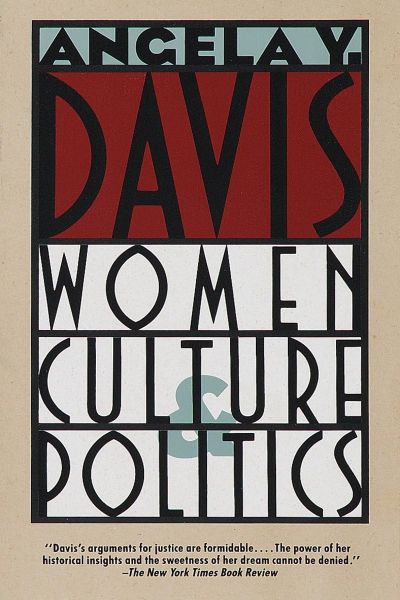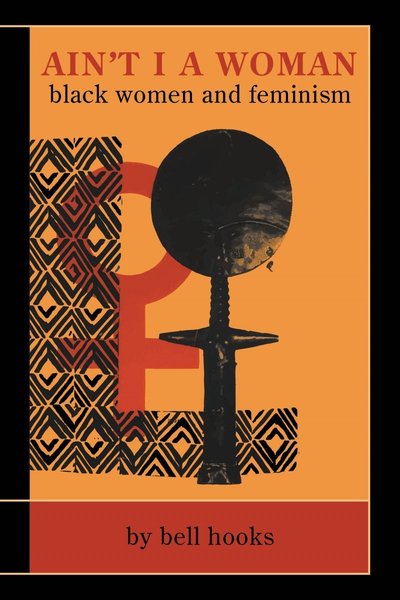Women, Culture & Politics
An important collection of speeches and essays by veteran political activist Angela Y. Davis, focusing on transformations in conversations about sexism, racism, and economic equality in the late 20th century. From stories of female circumcision in Egypt to examinations of rap lyrics, to the personal politics of race, Davis's sharp and accomplished essays establish her place among the important contemporary feminist voices.

📝 Book Review
Amid the political turbulence of the late 20th century, Angela Y. Davis emerged as one of the most influential radical feminist theorists and activists, providing precious intellectual resources for understanding the complex intersections of race, gender, and class through her profound insights and uncompromising critical spirit. “Women, Culture & Politics,” this collection of speeches and essays published in 1989, gathers her important reflections from the 1980s, revealing how a Black woman intellectual maintained a Marxist feminist stance while analyzing contemporary society’s structural inequalities against changing historical backgrounds.
As a former political prisoner, philosophy professor, and lifelong activist, Davis’s writing remains rooted in concrete political practice and social reality. Her analysis is not abstract speculation from an ivory tower but theoretical insights distilled from firsthand experiences in prison struggles, anti-racism movements, and international solidarity actions. This combination of theory and practice makes “Women, Culture & Politics” not only an important academic text but a guide for social transformation.
Pioneering Practice of Intersectional Analysis
One of “Women, Culture & Politics’” most important theoretical contributions is its profound analysis of the intersections of race, gender, and class. Although the term “intersectionality” was formally introduced by Kimberlé Crenshaw in 1989, Davis already demonstrated deep understanding and practical application of this concept in this work.
Davis points out that oppression faced by Black women cannot be simply understood as racial discrimination plus gender discrimination, but represents a unique, compound form of oppression. Within American society’s power structures, Black women can neither completely identify with white women’s experiences nor completely identify with Black men’s experiences. They must face multiple oppressions from white supremacy, patriarchy, and capitalist systems—a form of oppression with its own unique characteristics and impacts.
This intersectional analysis applies not only to Black women in America but to women of color globally. Through analyzing specific cases such as female circumcision in Egypt, Palestinian women’s resistance struggles, and women’s experiences under South African apartheid, Davis reveals similar predicaments faced by women from different cultural backgrounds while exposing how global capitalism, colonialism, and patriarchy interact to create complex networks of oppression.
The analytical framework demonstrates how different systems of domination compound rather than simply add together, creating unique forms of subordination that require specific theoretical and practical responses.
Critique and Reconstruction of Mainstream Feminism
Davis provides profound critical analysis of the mainstream feminist movement in 1980s America. She points out that while the mainstream feminist movement achieved important progress in fighting for women’s rights, it often ignored racial and class differences, primarily reflecting the experiences and needs of middle-class white women. This limitation not only weakened the feminist movement’s inclusivity but also restricted its transformative potential.
Davis particularly criticizes tendencies in certain feminist theories to essentialize all women’s experiences. She argues that while women indeed face common gender oppression, the specific manifestations of this oppression vary significantly due to differences in race, class, nationality, and other factors. Therefore, feminist theory must accommodate this diversity rather than simply categorizing all women’s experiences into a single pattern.
Davis also critiques certain feminists’ romanticized understanding of family and motherhood. She points out that for many working-class women and women of color, family can be both a refuge from external oppression and a site where oppressive relations are reproduced. Therefore, feminist analysis must handle this complexity and contradiction rather than simply viewing family as either obstacle to or sanctuary for women’s liberation.
The critique reveals how mainstream feminism’s limitations stem from its foundation in privileged women’s experiences, creating theoretical frameworks that marginalize rather than center the most oppressed women’s realities.
Deep Analysis of Cultural Politics
“Women, Culture & Politics’” analysis of cultural politics represents another important feature. Davis keenly realizes that culture is not merely a reflection of social reality but an important force shaping social reality. Therefore, fighting for cultural discourse power and changing cultural representations are indispensable components of social transformation.
In analyzing hip-hop music and rap lyrics, Davis demonstrates her complex and nuanced cultural criticism abilities. She both acknowledges the sexism and violent content existing in these cultural forms while recognizing their important value as Black community resistance to mainstream cultural hegemony. She points out that simply condemning these cultural forms is insufficient; more important is understanding their social background and their position within Black cultural traditions.
Davis particularly focuses on media representation’s impact on social cognition. She analyzes how mainstream media, through selective reporting and stereotype reproduction, reinforces negative stereotypes about Black women. These representations not only influence public perception of Black women but also affect Black women’s self-perception and expectations. Therefore, fighting for changes in media representation and creating more diverse and positive cultural images represents an important battlefield for feminist struggle.
The cultural analysis reveals how representation politics operate through seemingly neutral cultural products to maintain ideological frameworks that justify and normalize oppression.
Internationalist Vision and Global Solidarity
“Women, Culture & Politics” demonstrates Davis’s consistent internationalist vision and global solidarity consciousness. She places American racial and gender issues within broader global contexts for analysis, revealing how imperialism, colonialism, and global capitalism create and maintain unequal relationships worldwide.
Davis particularly focuses on Third World women’s struggle experiences. She provides detailed analysis of Palestinian women’s roles in occupation and resistance, South African women’s contributions to anti-apartheid struggles, and Latin American women’s participation in anti-dictatorship movements. Through these case analyses, she reveals common characteristics and unique forms of women’s resistance across different cultural backgrounds.
This internationalist vision not only reflects Davis’s concern for global justice but also provides important theoretical resources and practical experience for American social movements. She argues that American racial and gender problems cannot be understood and solved in isolation but must be analyzed within frameworks of global power relations. American social movements should also establish connections with liberation struggles in other parts of the world, learning from and supporting each other.
The global perspective demonstrates how local forms of oppression connect to international systems of domination while revealing possibilities for transnational solidarity and resistance.
Feminist Critique of the Prison System
As an important theorist of prison abolition, Davis provides profound feminist analysis of the prison system in “Women, Culture & Politics.” She points out that the prison system serves not only as a tool of racial control but also as a mechanism of gender control. Women in prison face unique predicaments and challenges, including sexual violence, medical neglect, and separation from children.
Davis particularly focuses on the prison system’s impact on women of color. She points out that Black women and Latina women’s proportions in prison populations far exceed their proportions in the general population, reflecting systematic bias in the criminal justice system. This bias manifests not only in sentencing disparities but throughout all stages of law enforcement, prosecution, and trial.
Davis also analyzes the prison system’s impact on communities, particularly on communities of color. Mass incarceration of men leads to changes in family structures, increasing women’s economic and emotional burdens. This impact operates not only at personal levels but at community levels, destroying communities’ social structures and cultural transmission.
The prison analysis reveals how mass incarceration functions as a system of social control that particularly targets communities of color while disproportionately affecting women as both direct victims and community members dealing with its consequences.
Economic Justice and Women’s Liberation
“Women, Culture & Politics’” analysis of economic issues reflects Davis’s consistent Marxist feminist stance. She argues that genuine women’s liberation must include economic liberation, which in turn requires fundamental transformation of the capitalist system.
Davis provides detailed analysis of women’s labor’s special nature under capitalism. She points out that women not only undertake paid labor but also bear large amounts of unpaid domestic labor and care work. This labor division not only increases women’s burdens but maintains patriarchal power relations. Therefore, fighting for economic equality cannot merely stop at equal pay for equal work but must reassess and redistribute various forms of labor.
Davis particularly focuses on working-class women and women of color’s economic conditions. She points out that these women often perform the most unstable, lowest-paid work while also bearing family responsibilities. The economic predicaments they face cannot be simply attributed to personal choices or ability issues but result from structural inequalities. Therefore, solving these problems requires systematic social transformation rather than individual-level efforts.
The economic analysis reveals how capitalism and patriarchy intersect to create specific forms of women’s oppression while suggesting that economic justice represents a crucial dimension of women’s liberation.
Education as Liberation Tool
As a veteran educator, Davis gives special attention to educational issues in the book. She believes education can be both a tool for maintaining existing unequal relations and a catalyst for promoting social transformation. The key lies in education’s content, methods, and goals.
Davis criticizes racial and gender bias in traditional educational systems. She points out that traditional educational content often ignores the historical contributions of people of color and women, reinforcing white male-centered knowledge systems. This bias not only affects students’ knowledge structures but also influences their identity formation and future choices.
Davis also proposes concepts of critical education. She believes truly liberating education should help students develop critical thinking abilities, understand social structures and power relations, and inspire their motivation and capacity to participate in social transformation. This education is not neutral knowledge transmission but practical activity with clear political goals.
The educational vision connects learning to social transformation while revealing how traditional education serves to reproduce rather than challenge existing power relationships.
Complex Analysis of Violence Issues
“Women, Culture & Politics’” analysis of violence issues demonstrates the complexity and depth of Davis’s thinking. She focuses both on violence against women and on state violence and structural violence issues. She believes these different forms of violence are interconnected and require holistic analysis and response.
Davis points out that violence against women cannot be understood in isolation but must be analyzed within broader violent culture contexts. She particularly focuses on state violence’s impact on communities and families, and how this impact exacerbates gender violence issues. For example, police violence and incarceration systems not only directly harm men of color but also indirectly affect women’s and children’s living conditions.
Davis also criticizes certain feminists’ simplified understanding of violence issues. She believes attributing violence problems entirely to patriarchy is insufficient; racial, class, and other factors’ influences must be considered. For women of color, they may simultaneously face violent threats from racism and gender discrimination, a complexity requiring more nuanced analysis and response strategies.
The violence analysis reveals how different forms of violence intersect and reinforce each other while demonstrating how anti-violence strategies must address multiple systems of oppression simultaneously.
Relationship Between Cultural Tradition and Transformation
Davis demonstrates profound understanding of the relationship between tradition and transformation in analyzing cultural issues. She both criticizes oppressive cultural traditions and recognizes resistance resources and transformative potential contained within cultural traditions. This complex cultural perspective reflects her theoretical maturity and political wisdom.
In discussing African cultural traditions, Davis both criticizes gender inequality factors within them and emphasizes their anti-colonial value. She points out that simply negating traditional culture often falls into cultural imperialism traps, while blindly maintaining traditional culture may perpetuate oppressive relations. Therefore, critical inheritance of cultural traditions is needed, maintaining cultural identity while promoting internal transformation.
Davis particularly focuses on music, literature, and other cultural forms’ roles in social transformation. She believes these cultural forms not only reflect social reality but can imagine and construct new social possibilities. Therefore, cultural workers have responsibility to create more progressive and liberating cultural products, providing spiritual resources for social transformation.
The cultural analysis demonstrates how progressive politics must engage with rather than reject cultural traditions while transforming them in liberating directions.
Reflection on Knowledge Production
As a scholar-activist, Davis also reflects on the political nature of knowledge production in the book. She points out that knowledge is never neutral but deeply embedded in specific power relations and social structures. Therefore, critical intellectuals have responsibility to expose bias and blind spots in mainstream knowledge systems and create alternative knowledge frameworks.
Davis particularly emphasizes practical experience’s importance in knowledge production. She believes that oppressed groups’ life experiences and struggle practices contain important theoretical insights, insights often ignored or marginalized by mainstream academia. Therefore, truly critical knowledge must integrate theoretical speculation and practical experience, providing powerful intellectual weapons for social transformation.
Davis also reflects on intellectuals’ social responsibility issues. She believes intellectuals cannot be satisfied with speculation in ivory towers but should actively participate in social practice, using their professional knowledge to serve social justice causes. This participation is not simple knowledge popularization but establishing genuine alliance relationships with oppressed groups, jointly promoting social transformation.
The knowledge critique reveals how intellectual work can serve liberation movements while challenging academic institutions that insulate scholarship from social transformation.
Future Vision and Action Strategies
“Women, Culture & Politics” includes not only critical analysis of reality but also visions for future society and action strategies for realizing this vision. Davis’s future vision is establishing a society without racial, gender, and class oppression—a society truly realizing equality and freedom for all.
Davis emphasizes alliance building’s importance in social transformation. She believes different oppressed groups need to overcome divisions and prejudices among themselves, establishing alliance relationships based on common interests and values. These alliances are not simple tactical cooperation but strategic partnerships based on deep understanding and mutual support.
Davis also emphasizes education and cultural work’s roles in social transformation. She believes social transformation requires not only political action but also ideological transformation. Through education and cultural work, people can understand existing systems’ irrationality, imagine alternative social arrangements, and inspire motivation and capacity to participate in transformation.
The strategic vision connects immediate struggles to long-term transformation while emphasizing how sustainable change requires both structural reform and consciousness development.
Continuing Significance for Contemporary Times
Although “Women, Culture & Politics” was written in the 1980s, its analytical frameworks and theoretical insights maintain strong contemporary relevance. Davis’s proposed intersectional analysis has become an important component of contemporary feminist theory, and her critique of the prison system has become important theoretical resources for contemporary prison abolition movements.
In the current “Black Lives Matter” movement, we can clearly see Davis’s thought’s influence. This movement focuses not only on police violence issues but also on broader structural inequality problems, embodying the holistic analytical methods Davis advocated. The important role of women activists in this movement also reflects the importance of gender and racial intersectionality that Davis emphasized.
In the globalization era, Davis’s internationalist vision also appears more precious. She reminds us that local social problems often have global roots, therefore requiring global solidarity and cooperation for fundamental solutions. This perspective provides important guidance for understanding and responding to contemporary global challenges.
The contemporary relevance demonstrates how theoretical frameworks developed in specific historical moments can remain vital for understanding evolving forms of oppression and resistance.
Theoretical Legacy and Influence
“Women, Culture & Politics’” theoretical legacy is multifaceted. First, it provided important early practice for intersectionality theory development, influencing later theoretical development. Second, it organically combined Marxist analytical methods with feminist theory, providing important frameworks for understanding gender oppression under capitalist systems.
Davis’s cultural politics analysis also influenced later cultural studies and postcolonial theory development. Her focus on cultural representation politics and critique of mainstream cultural hegemony provided important insights for understanding culture’s role in maintaining and challenging power relations.
At social movement levels, Davis’s theory and practice provide important inspiration for various contemporary social movements. From anti-globalization movements to climate justice movements, from prison abolition movements to immigrant rights movements, her influence traces can be seen. The alliance building, intersectional analysis, and international solidarity concepts she emphasized have become important components of contemporary social movements.
The theoretical influence demonstrates how engaged scholarship can contribute to both academic knowledge and practical organizing while building bridges between different sites of struggle.
Conclusion: Continuing Relevance for Liberation Struggles
Today, “Women, Culture & Politics” remains an indispensable theoretical resource for understanding contemporary social inequality issues. It reminds us that genuine social justice requires holistic transformation, cooperation among different groups, and combination of theoretical analysis with practical action. In a world still full of inequality and injustice, Angela Davis’s thought continues providing us with weapons of critique and hope for transformation.
“Women, Culture & Politics” is not only an important theoretical work but a declaration of action. It demonstrates how an outstanding intellectual can combine profound theoretical insights with firm political positions, working tirelessly to create a more just and equal world. Against the background of current global multiple crises, this spirit appears more precious and necessary.
The enduring power of Davis’s work lies in its demonstration that liberation requires both rigorous analysis of existing conditions and visionary imagination of alternative possibilities. By connecting local struggles to global systems of oppression while maintaining commitment to practical organizing and consciousness development, Davis provides frameworks for understanding how individual and collective transformation interconnect in ongoing struggles for justice, equality, and human dignity.
Her synthesis of theoretical sophistication and practical engagement continues to inspire scholars, activists, and educators working toward social transformation across multiple fronts and geographical locations. “Women, Culture & Politics” remains essential reading for anyone seeking to understand how various forms of oppression operate together while learning how resistance movements can build solidarity across difference to create more just and liberating alternatives.
Discussion
读书讨论
分享您对这本书的感想和看法,与其他读者交流见解
加入讨论
分享您对这本书的感想和看法,与其他读者交流见解
加载评论中...
Book Info
🛒 Get This Book
 Buy on Amazon
Buy on Amazon Related Books
读书讨论
分享您对这本书的感想和看法,与其他读者交流见解
加入讨论
分享您对这本书的感想和看法,与其他读者交流见解
加载评论中...

